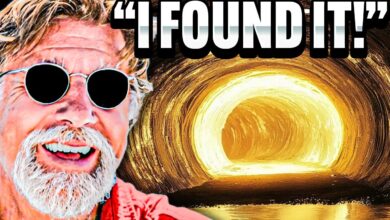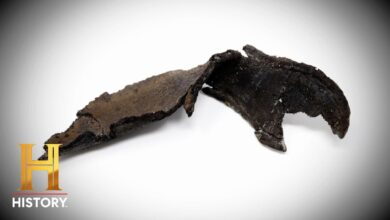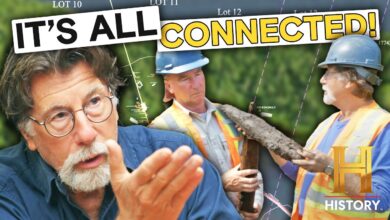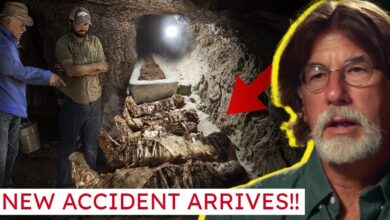Malta’s Hidden Caves Linked to the Knights Templar (Season 12) | The Curse of Oak Island
Malta's Hidden Caves Linked to the Knights Templar (Season 12) | The Curse of Oak Island

More than 4,000 miles to
the east in Valletta, Malta…
NARRATOR:
…researcher Emiliano Sacchetti has arranged for Rick Lagina and other members of the team to meet investigative journalist
Jean-Paul Mifsud for a guided tour
of one of Malta’s most mysterious
and renowned features.
EMILIANO:
Jean-Paul Mifsud is going to be our guide today. And we’re going to go down and take a look at the
underground part of the city. The one who was built
by the Knights of Malta.
NARRATOR:
In 1565, after defending Valletta
from an attempted invasion -by the Ottoman Empire…
-(man yelling)
NARRATOR:
…the Knights of Malta began a major renovation
of the city to create a stronghold
for their order. The new fortification
included a vast network of underground tunnels that were dug out
of the limestone bedrock. These tunnels offered not only
a safe haven in times of war for the Knights
and the citizens of Valletta, but also served
as secure storage facilities and featured elaborate cisterns
for collecting and controlling water. And according
to some researchers, the tunnels may have also served as a hiding place
for Templar-related treasures before they were transported
to the New World. It’s just absolutely incredible.
RICK:
As we are introduced
to this underground area, it’s massive. It is a highway,
literally underground. Various tunnels,
cisterns, chambers were developed and built
to sustain a siege. I think it was representative of the skills necessary
to construct a chamber or a vault or a room
that could hold treasure. But these were
the original cisterns. The function
of this was obviously -for the water.
-RICK: Mm-hmm. And it’s two… cisterns. So, there is a…
connecting arch there. We’ll go in.
And even further down, -it’s a bit deeper, also.
-ALEX: Mm-hmm. And at the end, there is a small
connecting tunnel, which links both reservoirs. So, this was done in 1570?
-JEAN-PAUL: That’s the era.
-ALEX: The way I hear the story, it was in response
to the Great Siege -that they did all this.
-Oh, yeah. Yes. Was direct response because the Knights were convinced that the Ottomans were going
to try another great siege.
-Mm-hmm.
-So, there’s an acute threat.
-Yeah.
-We’re looking for reasons they may have taken an interest in other locations,
even as far as Oak Island. This is evidence that they might
have been thinking that way, that they needed
to safeguard… things. So now, let’s go and have a look
at the tunnels.
-Let’s go.
-Perfect.
-ALEX: Okay. After you, sir.
RICK:
Everything that we’ve seen
regarding the efforts of the Knights of Malta–
it’s an incredible undertaking. They needed structures
like these to protect their possessions,
to protect themselves. that’s easily explainable here,
the “why.” On Oak Island, it’s not quite
so easy to explain, but perhaps
some answers lie within. It’s almost surreal.
JEAN-PAUL:
In the Knight’s era, this would have been
the passageway, which passes exactly underneath
the street up at the top. You can really see
the difference in the tools that they used.
JEAN-PAUL:
It’s a kind of rock
which you can chisel away straight. Is this clay? It’s grayish, blueish,
it’s softer than the limestone. The blue clay
played an important role, because you have, like,
a natural sealant. And you come across something -similar on your island?
-SCOTT: Yes. We know that waterproofing
with blue clay had to be done in the Money Pit.
SCOTT:
Waterproofing was one of the keys
in working on the island, because it was an island.
NARRATOR:
Is it possible
that Rick and the team have just seen a
waterproofing method in tunnels that were created
by the Knights of Malta, which matches
the reported design of the original
Oak Island Money Pit? We know, based on our work
in the Money Pit, that blue clay was used
to waterproof things. The shafts, in particular.
Perhaps the tunnels.
-ALEX: That’s amazing.
-RICK: Mm-hmm. Might it be replicated here? Because we know
that they needed some way to waterproof the aqueducts
and the underground cisterns. So, it’s quite impactful
to see it here. The original description of the original find
of the Money Pit, where the treasure
would have resided– you could see the same things.
There was no cribbing. You could see the strike marks
on the walls. It was that
tightly consolidated. It was very competent ground. Could this have been done
long ago on Oak Island? I’d say it’s definitive. All of the things that we see exhibited of the Knights of Malta’s
capabilities underground certainly are exemplified
underground in the Money Pit. We have limestone,
we have blue clay. And someone found a way
to move water from the ocean to the Money Pit. So, is it possible
that this same type of work by the same peoples,
might that have been used to do the same type of work
on Oak Island? It’s possible. And at some point,
that might be provable.
-Well, for us, there’s more to see in Valletta. So, let’s resurface.
-PETER: Thank you.
-CORJAN: Thank you so much.
NARRATOR:
Some 4,000 miles to the east, off the coast of Malta…
CORJAN:
From one island to another.
-RICK:
One beautiful island to another.
-ALEX: Yeah.
NARRATOR:
…Rick Lagina
and members of the team are being transported
to the island of Gozo, where the Knights of Malta
established one of their strongholds in 1565.
-EMILIANO: We brought some
of the artifacts.
-Yeah. Because maybe
we can find some connection.
NARRATOR:
There, the team will visit
the Citadel of Victoria in the hopes of making
more possible connections between the Knights of Malta
and the Oak Island mystery.
-Hey, Denis. How are you?
-Hey. Hi. How are you?
NARRATOR:
Denis Darmanin
is a Maltese historian and leading expert on military artifacts and buttons,
and today, Corjan Mol and Emiliano Sachetti have arranged for Denis
to analyze the starburst button that was found
on Lot 5 one year ago.
-Well, sir,
I have a button to show you.
-Oh.
DOUG:
Our archeologists– they believe
it has the potential to be one of the oldest buttons
we’ve found on the island. Let’s see.
-There you go.
-That’s all right. There it is.
Ah, well, the pattern is
more likely a Spanish pattern.
-Mm-hmm.
-DOUG: That’s interesting,
because some members of the Knights
of Malta came from Spain. Of course.
And what I can add to that is, I did come across
a similar pattern here. And according to the sizes,
they were either worn on the waistcoat,
or else they were worn, the larger sizes,
on their coats. I would date it to about 1650,
not later than 1675.
-Hmm.
-That’s crazy. That may indicate a period
of construction for that feature -on Lot 5.
-Yup. Correct. It’s more than a hundred years, before the discovery
of the Money Pit.
-Yeah.
-It’s quite remarkable.
-Yes.
-Yes. I quite agree. And this design was quite,
sort of trendy.
DENIS:
These buttons were more trendy
with the aristocratic level. So, the Knights would hold
their status in what they wear. Yeah.
JUDI:
So, we’d like
to show you a picture of a uniform
that might have had a button
-like that with a swirl on it.
-Sure. Sure.
JUDI:
Like to get your thoughts
on that. Yes. It’s a similarity. Either it’s a button
exactly like it,
-or of a larger size.
-Mm-hmm. Because a coat button–
that would be larger than, let’s say, a vest button -or a waistcoat button.
-Right. So, with this starburst button
in particular, there is a possibility that this
button would have been worn by somebody, a member
of the Knights of Malta.
Oh, yes, I agree. Well, that’s a pretty
exciting possibility.
RICK:
I find that to be -very, very interesting.
-Yeah.
NARRATOR:
If Denis Darmanin is correct that the so-called
starburst button may very well have come from the uniform of a member
of the Knights of Malta, could it help prove
that the order was connected to the Oak Island mystery?
RICK:
We now have a visit predating the discovery
of the Money Pit by a significant amount of time,
but to what end? This may be the button
that explains what the Lot 5 feature
possibly represents. You know, Denis, we can only
solve the treasure hunt by looking to the past in order to understand
what lies ahead of us.
-Yes.
-RICK: But you have
certainly given us great insight, and we really,
really appreciate it.
Well, my final comment is,
I’m always here to assist. (laughter)
-RICK: Thank you very much.
-DENIS: It’s an honor.








